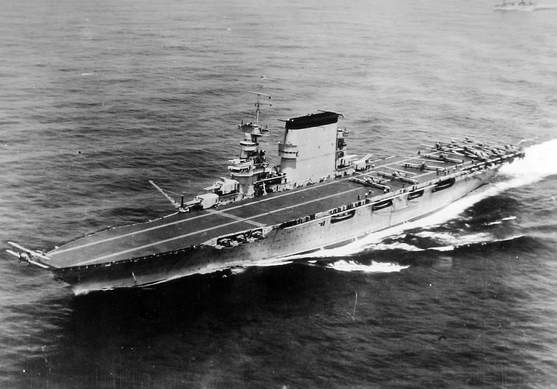Sinking of the Carrier Lexington
By James Donahue
The USS Lexington was among the first aircraft carriers to join the United States naval fleet. Launched at Quincy, Mass. In 1925, this ship and her sister carrier, the Saratoga, were assigned to the Pacific Fleet where they developed carrier tactics that included staging a mock attack on Pearl Harbor in 1932.
The hulls of both carriers were originally designed to be battleships but were converted to be aircraft carriers based on advanced engineering occurring at that time.
The Lexington was 888 feet in length, carried up to 78 aircraft and a total complement of 2,791 men, including the aircraft personnel.
Both the Lexington and Saratoga were at sea when the Japanese struck Pearl Harbor so they were key elements in the nation’s counter attacks those first months in the Pacific Theater. Lexington was severely crippled by Japanese aircraft during the Battle of Coral Sea in May, 1942. A total of 2,735 crewmen were safely removed from the burning ship before the destroyer Phelps scuttled it by firing five torpedoes into the hull. Another 216 sailors died.
The wreck was discovered in March, 2018 by the research ship R. V. Petrel lying about two miles deep and about 430 miles off the coast of Queensland. A remotely operated underwater vehicle confirmed the wreck was the Lexington. The wreck is broken into three parts. Aircraft were found well preserved lying just west of the wreck.
War historians may be somewhat confused by the fact that a second carrier named Lexington was also active in the Pacific Theater during that war. She was a new Essex-class fleet carrier that was launched at the Quincy shipyard shortly after the first carrier was lost. It was commissioned the USS Lexington (CV-16) in February, 1943. This ship served as the flagship of Task Force 58 during the Battle of the Philippine Sea. It remained in service until 1991.
By James Donahue
The USS Lexington was among the first aircraft carriers to join the United States naval fleet. Launched at Quincy, Mass. In 1925, this ship and her sister carrier, the Saratoga, were assigned to the Pacific Fleet where they developed carrier tactics that included staging a mock attack on Pearl Harbor in 1932.
The hulls of both carriers were originally designed to be battleships but were converted to be aircraft carriers based on advanced engineering occurring at that time.
The Lexington was 888 feet in length, carried up to 78 aircraft and a total complement of 2,791 men, including the aircraft personnel.
Both the Lexington and Saratoga were at sea when the Japanese struck Pearl Harbor so they were key elements in the nation’s counter attacks those first months in the Pacific Theater. Lexington was severely crippled by Japanese aircraft during the Battle of Coral Sea in May, 1942. A total of 2,735 crewmen were safely removed from the burning ship before the destroyer Phelps scuttled it by firing five torpedoes into the hull. Another 216 sailors died.
The wreck was discovered in March, 2018 by the research ship R. V. Petrel lying about two miles deep and about 430 miles off the coast of Queensland. A remotely operated underwater vehicle confirmed the wreck was the Lexington. The wreck is broken into three parts. Aircraft were found well preserved lying just west of the wreck.
War historians may be somewhat confused by the fact that a second carrier named Lexington was also active in the Pacific Theater during that war. She was a new Essex-class fleet carrier that was launched at the Quincy shipyard shortly after the first carrier was lost. It was commissioned the USS Lexington (CV-16) in February, 1943. This ship served as the flagship of Task Force 58 during the Battle of the Philippine Sea. It remained in service until 1991.
